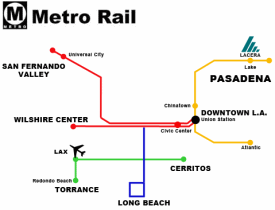How bullet-train fiasco maintains support, momentum
by CalWatchdog Staff | April 15, 2013 8:52 am
April 15, 2013
By Wayne Lusvardi
 It may be unpleasant to contemplate, but opposing California’s high-speed rail project with a green-eyeshade strategy that targets its estimated huge annual losses seems likely to be a loser. Project opponents may need to find another approach, given how such big projects can maintain momentum no matter how bad the headlines get.
It may be unpleasant to contemplate, but opposing California’s high-speed rail project with a green-eyeshade strategy that targets its estimated huge annual losses seems likely to be a loser. Project opponents may need to find another approach, given how such big projects can maintain momentum no matter how bad the headlines get.
The findings of a new study by the independent Reason Foundation[1] could hardly be more damning. It details how the California High-Speed Rail Authority overestimated ridership by up to 77 percent and that San Francisco-to-Los Angeles train trips would take a slow four hours. But the research is likely to fall on deaf ears among many constituencies, starting with the influential unions and trade groups who love the prospect of construction jobs and the wealthy energy industrialists and entrepreneurs who benefit from green power subsidies.
One particularly crucial constituency is the local officials on the bullet train’s route. The cities that would get train stations would get most of the benefits of transit-oriented real estate development and tourism. But the costs would be spread over all the state’s taxpayers through a general obligation bond rather than a project-specific revenue bond.
Stated differently: The costs and the impacts would be socialized, but the benefits would be mostly localized and privatized. This means cities with designated high-speed rail stations are likely to be advocates for the project.
A ‘loss leader’ helping utilities, others
What often drives public infrastructure projects is not the prospect of making money — positive cash flow above costs — but the positive side effects from induced economic development.
 In the business world, money-losing tactics that yield positive side effects are called “loss leaders.” McDonald’s loses money on its hamburgers but makes a windfall on french fries, Cokes and shakes.
In the business world, money-losing tactics that yield positive side effects are called “loss leaders.” McDonald’s loses money on its hamburgers but makes a windfall on french fries, Cokes and shakes.
Similarly, high-speed rail could be a major purchaser of green power. Thus, solar, wind and geothermal energy subsidiaries of the three major regulated public utilities in the state — PG&E, Edison and SDG&E — would likely benefit. This would result in another class of beneficiaries of the project.
Consider Los Angeles’ stealth purchases of farmland and water rights in Owens Valley in the early 20th century. The project didn’t make any economic sense until there was greater population growth in the Los Angeles basin. But the project was as much about land speculation in San Fernando Valley as it was about water. The spillover effect of the water was increased land values.
This is why it is said water runs uphill toward money. And boondoggle rail projects are often unstoppable because of the community and corporate wealth effects that trains and train stations can potentially create.
And this is why California’s high-speed rail project is a runaway train that can’t be easily killed. It’s a stealth redevelopment project mainly for central California cities where the state’s future growth is forecast — one with a built-in subsidy for green power.
Anticipating benefits that may never materialize
But this theory, while it may explain how the bullet train keeps moving forward, isn’t necessarily built on sound reasoning.
For one example, a bullet train is unlikely to spur housing redevelopment around its train stops, as has light rail. If it did, Amtrak — which already provides long-range commuter service throughout California — would have seen much more transit-oriented development at its stops.
 Light rail in San Gabriel Valley in Los Angeles County — called Metro Rail[2] — has been a loser on a cost-per-rider basis. But it is still wildly popular with cities along its route due to its positive real estate economic side effects. Even though Amtrak is a better parallel to the bullet train, the Metro Rail’s popularity gives a boost to the state project.
Light rail in San Gabriel Valley in Los Angeles County — called Metro Rail[2] — has been a loser on a cost-per-rider basis. But it is still wildly popular with cities along its route due to its positive real estate economic side effects. Even though Amtrak is a better parallel to the bullet train, the Metro Rail’s popularity gives a boost to the state project.
Then there is another big selling point by Gov. Brown and the state Legislature: that the bullet train would reduce air pollution. But the problem of outdoor air pollution is not only the amount of polluted particles in the air but the geography of air basins[3]. The Central Valley is an air basin surrounded by mountain chains on three sides.[4] Thus, Visalia and Fresno have high air particle levels and flat and windy Lancaster-Palmdale[5] has low levels. High-speed rail won’t reduce much air pollution in the Central Valley anyway because the bulk of the long-distance commuters are not business or tourist travelers.
Most impartial studies[6] of the social costs — accidents, congestion, noise, pollution, relative travel time, etc. — have found that high-speed rail has the highest and most undesirable social costs and air travel the least. Moreover, permanent economic development induced by high-speed rail is too speculative and unquantifiable to be included in most cost-benefit studies. And whatever economic development might result would likely be 20 years from now.
Rail proponents also minimize the overall $68 billion project cost by focusing on annual costs. If the share of cost to state and local governments is $26 billion[7] that reflects only $1.789 billion annual bond principal and interests costs at a 5.5 percent interest rate over 30 years. But that $1.789 billion could instead go to plug the public pension gap or help fund the much more needed Delta Tunnels and two new water storage reservoirs.
The stronger argument against the boondoggle?
High-speed rail critics may think they are doing a good job making the case against the project. But the fact is that for all their efforts, construction is expected to begin soon in the Central Valley. Proponents have been able to keep enough of the public — and enough special interests — on their side by emphasizing near-term construction jobs, green power development, and speculative long-term real estate and tourist development.
For this reason, it may be time for opponents to begin focusing more on the negative social costs — starting with the massive disruption now unfolding in the Central Valley — and the shaky prospects for promised economic development than on the high costs per rider and the negative operating and financial costs.
Emphasizing the extreme long-term cost may also win over some wavering parties. For example, the Brown administration’s claim that it could readily trim $30 billion from the project’s previous tab of $98 billion and still have a true statewide high-speed rail system is ripe for attack. It was this revision that led bullet-train pioneer Quentin Kopp to renounce the project[8].
One way or the other, the need for new tactics appears clear. It might be painful, but high-speed rail opponents need to “bite the bullet”[9] and realize that focusing on accounting details like estimated losses per rider is not likely to result in a red light for the project.
- Reason Foundation: http://reason.org/news/show/study-california-high-speed-rail
- Metro Rail: http://en.wikipedia.org/wiki/Metro_Rail_(Los_Angeles_County)
- geography of air basins: http://www.amazon.com/Introduction-California-Natural-History-Guides/dp/0520247485/ref=sr_1_1?s=books&ie=UTF8&qid=1365749783&sr=1-1&keywords=carle+air
- mountain chains on three sides.: http://www.theatlanticcities.com/neighborhoods/2011/09/behind-pollution-californias-central-valley/207/
- Lancaster-Palmdale: http://www.theatlanticcities.com/neighborhoods/2011/09/behind-pollution-californias-central-valley/207/
- impartial studies: http://rational.ce.umn.edu/Papers/CaliforniaCorridor.pdf
- 26 billion: http://www.gao.gov/assets/660/650608.pdf
- renounce the project: http://www.dailybulletin.com/opinions/ci_22917825/californias-bullet-train-loses-important-fan
- “bite the bullet”: http://en.wikipedia.org/wiki/Bite_the_bullet
Source URL: https://calwatchdog.com/2013/04/15/ready-how-bullet-train-fiasco-maintains-support-momentum/